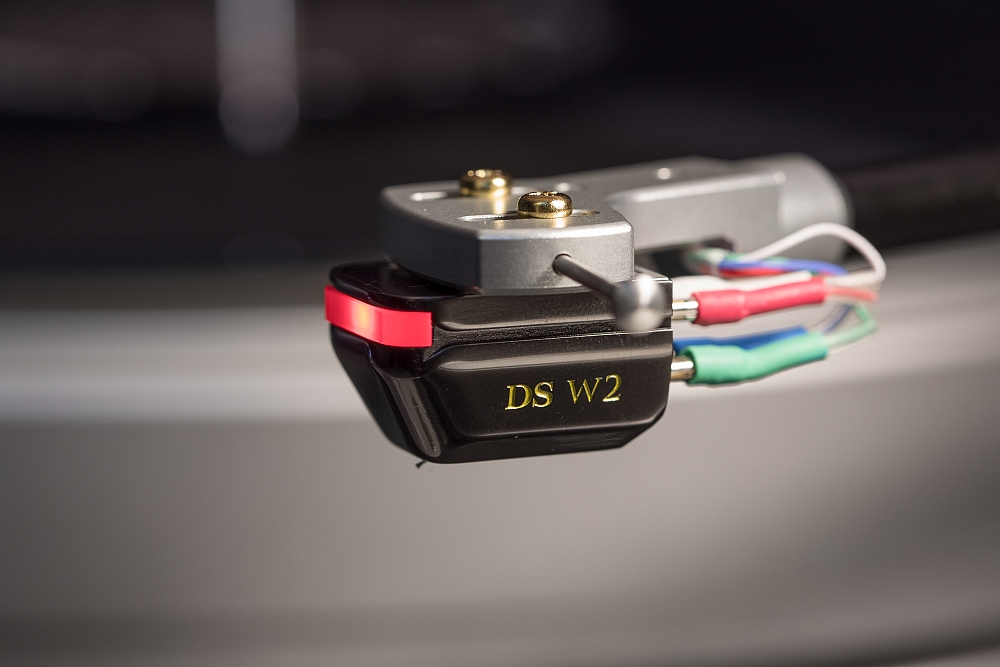It’s Friday night. The working week is (hopefully) over. You sit down with a single malt, a Shiraz, some umeshu or maybe just a mug of chocolate milk. You then seek out one of your favourite albums, undertake your particular pre-play ritual and finally lower the cueing arm. Thus enters the DS Audio DS-W2 cartridge and equaliser combo…
There it is… That’s what you’ve been waiting for. That’s the song that’s been tumbling around inside your head for the last five days. Often, as you relax and immerse yourself in the performance, perhaps even forgetting that you’re listening to a ‘system’ and not the real deal, it suddenly occurs to you. How on earth is this even happening?
A slither of precious stone cantilevered from an exotic yet small fishing pole, dragging its way through a plastic trough, makes… music?
I don’t know how often this happens to you, but this thought pervades my psyche fairly frequently, and every time it does I return to first principles about what I know of vinyl playback and instantly demystify the apparently magnificent. Music lovers have come to accept the status quo of playback but there were and are clearly those who aren’t satisfied to simply accept what is and just move on.
For some 25 years, one very accomplished Japanese outfit, Digital Stream Corporation (DSC) has been pioneering engineering solutions in the world of laser optics, and more recently have turned their attention to re-thinking the analogue optical cartridges from the 1970s.
The beginning of the story
Founded in 1989 by Tetsuji Aoyagi, DSC positioned itself as a market leader in design and manufacture of various laser optical instruments and optical pickup heads for media evaluation systems, required to guarantee optical disc compatibility and quality. DSC has further explored the applications of laser technologies in PC input and gaming devices, co-developing the optical mouse with Microsoft and receiving their outstanding engineering excellence award in 1995. DSC technology was further utilised in the first iteration of universal serial bus (USB) applications, and the company has also received a variety of industry awards within Japan.
Clearly, DSC is a serious operation; but it was through an appreciation by Tetsuji’s son, Tetsuaki, of how musical communication and emotion was maximally imparted through conventional vinyl analogue media that the subject of this review was born.
DS Audio, a subsidiary of DSC was formed in 2014, with the young Tetsuaki Aoyagi at the helm as CEO. Aoyagi was captivated by the performance merits of the early optical cartridges and how they assisted in elevating his enjoyment and appreciation of the medium. They have now been all but eschewed in favour of modern MC and MM cartridges, and indeed the even more contemporary compact disc, in light (pun intended) of their excessive weight, optical inconsistency, heat generation and suboptimal signal-to-noise ratios. Drawing on the successive developments in optical technologies, many of which have been piloted by DSC, Aoyagi yearned to reinvent the humble optical cartridge by reverse engineering early examples (such as the Toshiba), substituting their flaws with solutions of design excellence. Aoyagi makes several compelling arguments touting the benefits of the optical cartridge over conventional units.
Traditional MM and MC cartridges utilise a small magnet or small coil respectively attached to a cantilever and stylus, which in response to deflections imparted by the playback media cause relative movement between the coil and magnet, generating electromotive force. In these cartridges the voltage generated will be proportional to the velocity or speed of this movement. At lower recorded frequencies, the movement generated will be slow, whereas higher recorded frequencies will induce faster movements, creating manifest differences between the signal amplitude at high and low frequencies, necessitating the need for radical equalisation.
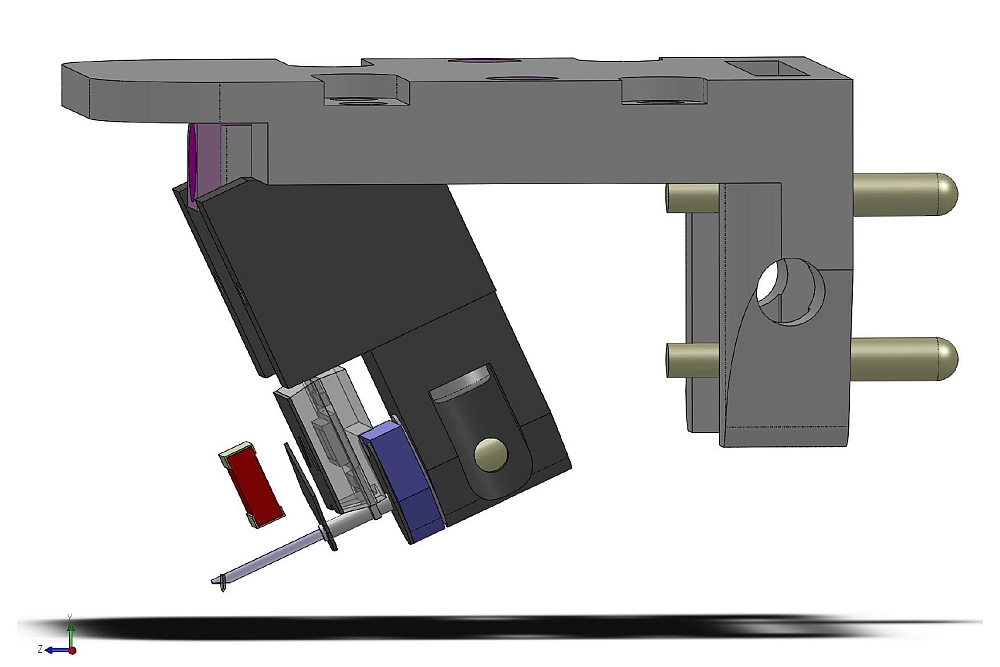
Furthermore, as the operation of MM and MC cartridges is governed by Faraday’s law of induction, a frictional force will be generated (a current with opposing magnetic field – Lenz’ law) effectively damping rapidly dynamic movements, affecting the ability of the system to accurately reproduce or transcribe the recorded material.
Aoyagi’s optical cartridges are different. They instead utilise a lightweight and colour-fast LED (gaining power by a DC offset supplied by the connecting phono clips) whose output is constantly read by a photodetector. A light screen is attached to the cantilever, and protrudes between the light source and detector, which modulates the light intensity in response to the groove content, creating a signal that is proportional to the amplitude of the stylus/cantilever movement (rather than to its speed).
This system therefore obviates the need for RIAA equalisation that would have been required with MM and MC carts, and allows the transcription of exceptional low frequencies, while doing away with the weight of a magnet/coil system.
Furthermore, the induced opposing magnetic field generated by the coil/magnet interaction in MM and MC carts doesn’t exist in an optical system, facilitating completely free movement of the stylus/cantilever system and an increased ability to track finer details within the vinyl groove.
Important to DS Audio and to anyone prospectively considering this cartridge is that this is not a digital system (as can often be the case with optical devices). This system is completely analogue as there is no quantisation or stepping of the output signal from the cartridge. It’s the same analogue endpoint, just facilitated by a different means.
Another important difference to understand about DS Audio cartridges is that they do not hook up with your existing phono stage or step-up transformer. As RIAA equalisation is not required, the equalisers supplied with each DS Audio model can be thought of as highly over-engineered output stages, housing larger capacitor banks than most relatively large power amplifiers. The DS equalisers directly interface your DS Audio cartridge to your line stage; a prospect which also makes them very price-competitive in a world full of extremely high priced front-end separates.
Climbing towards the light
The DS-W2 is not DS Audio’s first bite at the apple. Rather, it is the direct successor to the DS-W1 model, an award-winner with two well-renowned German audio magazines. The W2 refines several design elements including the switch from Shibata to Micro-ridge stylus profile, movement of the cantilever closer to the photodetector for improved accuracy, and significant modification in the quality and size of the equaliser unit.
The W2 is the second-from-the-top in the DS line-up, just under the Master 1. The relative newcomer, the DS-002 sits at the company’s entry point, however a new base model the DS-E1 is soon to launch in early 2019.
Within the DS stable, a particular equaliser unit is designed to offer performance commensurate with its partnering cartridge however any of the company’s equaliser/cartridge combos can be mixed and matched (for example you could upgrade the performance of your DS-W2 with the purchase of a Master equaliser). This is a sensible upgrade path for those who already own a DS model and wish to take a step up without the replacement of their whole DS suite.
The W2 is the first of the DS Audio offerings that I have heard, so my review conclusions will be solely based on that experience, but without giving anything away, I’d encourage anyone to seriously look at their differently priced options when considering a new analogue setup. Secondary to their mix-and-match approach, DS Audio effectively make solutions for a range of price points, and present themselves as even more attractive to those who have not as yet dropped considerable coin on an outboard phono stage.
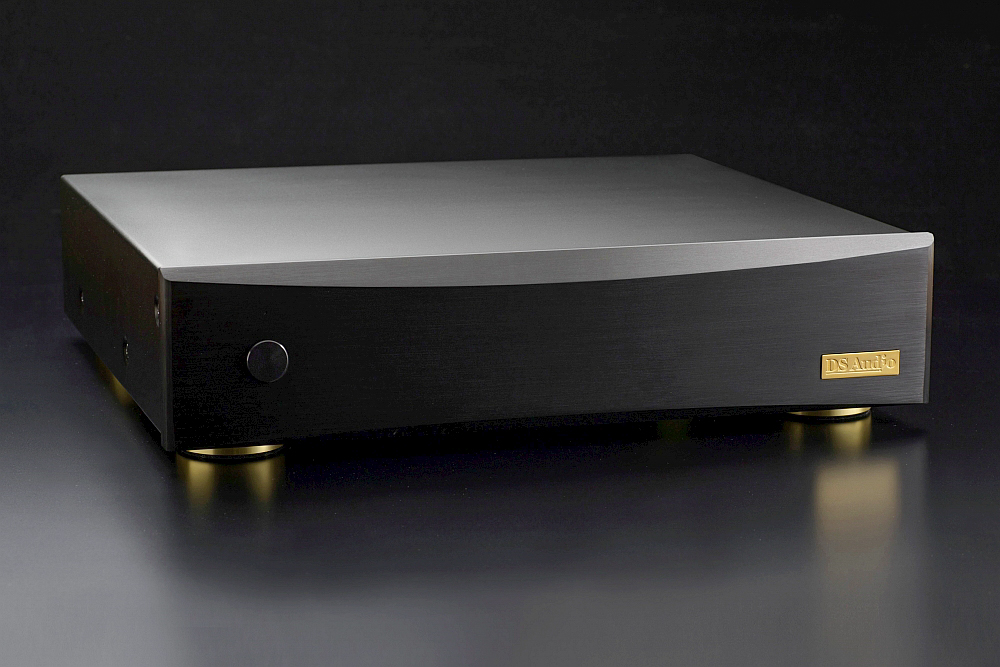
The DS-W2 weighs in at 8.1g with an output of 50mV or more (irrelevant really considering you’ll be using it with one of their equalisers). It uses a micro-ridge stylus mounted on a boron cantilever. The cartridge body is aluminium. Recommended tracking force is between 1.6 and 1.8g.
The matching DS-W2 equaliser weighs in at a solid 12kg and measures W43cm × H10.7cm × D38.4cm. It is a handsome unit with only a single push button on its thick anodised aluminium front panel, illuminating the horizontal crimson ‘nightrider’ panel on the phono cartridge. The unit feels very sturdy and is mounted on four solid felt-lined feet, allowing you to place it on top of your shelves (or other equipment) without fear of scratches. Internally, it boasts a capacitor bank of twelve 56,000uF caps, connected together by 1.5mm-thick pure copper bus bars to ensure maximum power transfer and also to act as considerable shielding for the unit’s transformer. It features RCA inputs and two sets of XLR and RCA outputs (single cut-off – with a 6dB rolloff below 30Hz, and dual cutoff – with a 6dB roll-off below 50Hz and again below 30Hz).
Both the cartridge and equaliser came well-boxed with plenty of internal packing to prevent transport trauma. A handwritten note from Tetsuaki Aoyagi accompanies each unit, which was a very nice touch, really contributing to the feeling that you’re about to unwrap something very special.
Setup
The DS-W2 was mounted on my Kuzma Airline tonearm and TW Acustic Raven AC (with Black Night motor/controller). VTF was set to 1.75g and VTA/SRA was set to 92 degrees with a DinoLite microscope and software suite. It is important to note that the DS Audio cartridges are not very tall (they’re rather stout in fact), so I advise ensuring that your setup possesses the ability to drop your arm height down to well below what you’re likely used to. With the VTA set at the lowest possible setting, the base section of the Airline (which perforates the armboard) was a mere hair’s breadth away from abutting the TW’s plinth in my setup with the DS-W2. I was fortunately able to maintain the correct SRA, but a different setup may have been less permissive.
DS Audio have in the Master and DS-W2 altered the configuration of the cantilever suspension to approximate closer the setup found in most conventional cartridges, making the compliance setting more accommodating to a wider variety of tonearms (not just the super lightweights). Although not disclosed, I believe this figure is now closer to the Japanese ‘default’ of 10 x 10-6/dyne, making it an apparently suitable partner for the Airline. Again, it would well be worth your while to check if your tonearm is compatible in this domain too.
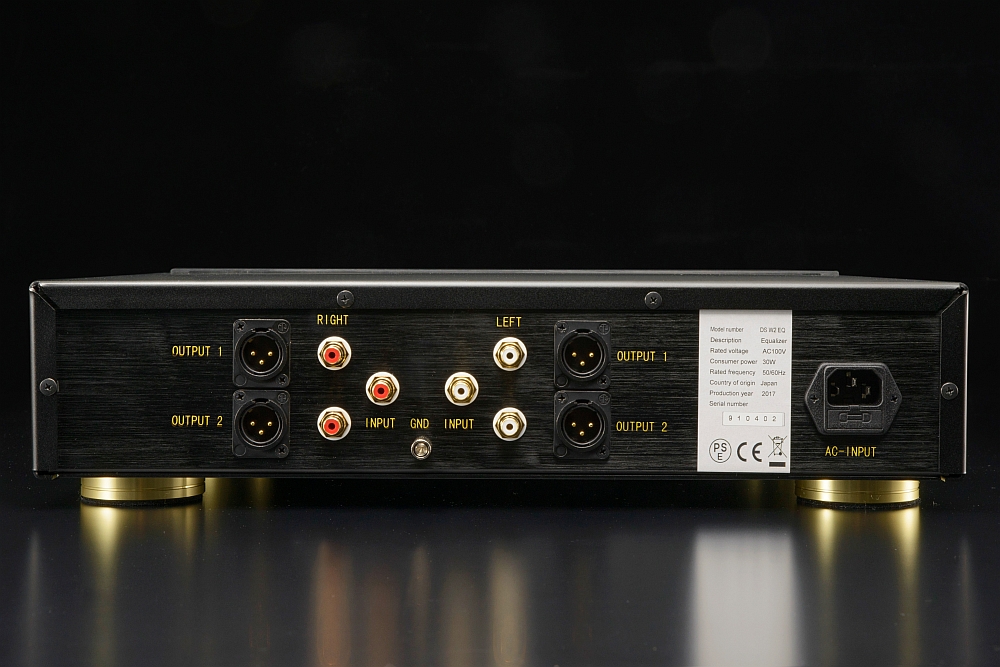
Feickert Adjust Plus was used for azimuth adjustment. I won’t quote my final crosstalk settings, suffice it to say that DS Audio’s specified >25dB channel separation was very conservative.
I used the single cut-off RCA outputs for the duration of my review sampling, connecting the equaliser to my Halcro dm10 line stage via a set of EnKlein Aeros Extreme interconnects.
Like most high-end electronics, the DS-W2 and its equaliser required a considerable amount of break-in time. My total listening time over the review period was likely close to 200 hours, however I was inclined to leave the equaliser switched on (even without any content running through it) for extended periods. This seemed to enhance the rate at which the unit broke-in and my review set appeared to stabilise at around 150 listening hours.
Sound at the speed of light
This is a cartridge that is quick to communicate what it does best and similar to its departure from conventional operation, the DS Audio DS-W2 sounded dramatically different from any other phono cartridge I have ever heard. The W2 demonstrate considerable excellence in the following areas:
- Speed and the discrimination of recorded space.
- Fidelity to tonality and detail retrieval, possessing a complete absence of blur or haze.
- Superb background quiet.
- The ability to un-homogenise complex musical passages and render them with an almost unparalleled sense of ease.
Music through the DS Audio pairing was consistently effortless and completely fatigue-free. Even with poorly recorded material, the duo never at any stage sounded edgy or strident, despite maintaining truth to the source material. Indeed, The DS Audio never lied about the quality of a recording – clearly differentiating the good from the bad, and teasing out inter-pressing variations. I believe this characteristic to be a hallmark of quality audio components. Those looking to sugar-coat the chaff of their record collections can look elsewhere, however rest assured that an investment in a DS-W2 will never leave you disappointed with your records. Rather than merely rendering them with brutal honesty, the DS certainly tells no lies, but delicately imparts the best attributes of what may be some of your favourite tunes, allowing previously unheard details to become manifestly clear… A cliché, I know, but all too true in the case of the W2.
The differences between my Australian and Japanese pressings of Kate Bush’s Never for Ever album have never been quite so obvious and, although clearly favouring the Japanese offering for its lower noise floor, greater dynamics and greater tonal accuracy, the DS still allowed for the best of the Aussie pressing to shine through, making it far more listenable in comparison to playback via the MySonic Signature Gold running straight into the Halcro’s phono stage (sans Ypsilon SUT). In either case, however, the DS fleshed out micro detail and in particular, allowed me to much more clearly make out the lyrics of the song, elevating the vocals above the background in an almost ethereal way.
The DS possessed a unique ability to emphasise the quiet in vinyl passages. Although never suppressing the recording’s surface noise, the W2 was able to somehow ‘decouple’ it from the musical performance, allowing you to disregard it more than with any conventional vinyl playback I’ve experienced.
Playing technique in Antonio Forcione’s Touchwood was admirably showcased, assisting in divorcing the sublime performance from the speakers and rendering the details more akin to a ‘live’ guitar than previously heard. Similarly, the hall ambience and remarkable background details in the Classic Records single-sided 45rpm release of Harry Belafonte’s Live at Carnegie Hall was divine. The DS Audio’s ability to retrieve these subtleties further reinforced my disbelief at the staggering quality of this vintage recording and the nearly limitless potential of vinyl as a medium.
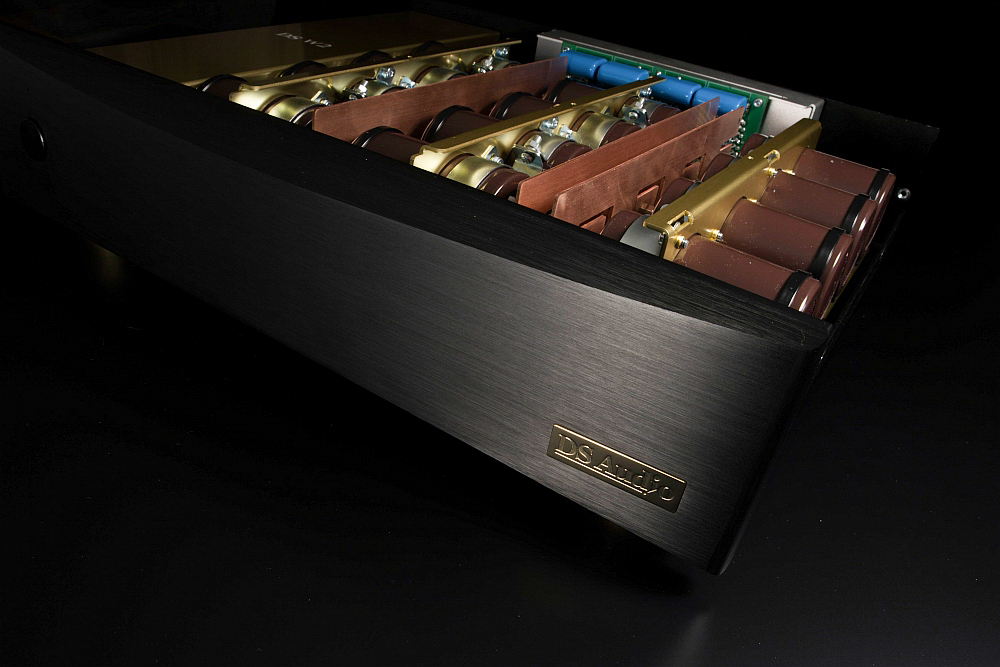
Jazz recordings such as Nebula by the Manabu Ohishi Trio were infused with life, easily emphasizing the instrumental timbres and musicians playing as individuals, and as a unified whole. The velvety and seductive saxophone playing in Grover Washington’s Winelight and Strawberry Moon albums was perhaps even more satisfying. The clarity, vivaciously sassy and flirtatious vocals of “Keep in Touch” was just the proverbial cherry on this cake. It was this kind of ease that so often left me listening to my system for hours with the W2 in play.
The DS Audio combo was capable of unleashing the extremes of the frequency spectrum, such as from the Audio Fidelity reissue of the Vangelis Blade Runner soundtrack. Bass performance was literally room-shaking yet articulated with a smoothness and refinement that often eludes all but the best vinyl playback when plumbing the deepest depths. The gossamer-delicacy of the chiming sounds in the opening track were so superbly contrasted to the iron-fisted and taut bass, the glistening highs helping to fill the room with an immense and airy soundstage.
If the DS failed to blow me away in one area, it was that of absolute macrodynamics. Although rich in tempo precision and able to seamlessly render the frequency extremes, it was the DS Audio’s reticence in involvement and slam that at times left me ever so slightly wanting. While in no way deficient, I would classify its character in this regard as slightly more polite in comparison to the most rhythmically engaging cartridges I’ve sampled. The absence of the last word in boogie was most manifest on poorly-recorded or pressed material, perhaps truthfully exposing the native shortcomings of the media rather than demonstrating a failure in its own performance capabilities.
It’s also a possibility that the Airline, despite in theory being an appropriate match in terms of resonant frequencies, was simply not the finest of dance partners for the DS-W2? Setup parameters aside, the DS-W2, like many cartridges or any other high quality audio equipment, must be carefully mated to other elements in the system to bring out the best results.
Conclusion
The DS Audio DS-W2 cartridge and equaliser are in my experience without parallel. They render analogue recordings in an absolutely unique way, maintaining an unquestionably analogue sound while imparting a variety of characteristics that make them decisively different to any other cartridge-phono stage combination I’ve heard.
Aoyagi’s passion for music is truly admirable and one cannot help but feel a great deal of respect for this extremely ingenious company, and its remarkable products. Aoyagi’s dedication and purpose is palpable in the quality and the sound of the DS-W2, and the worldwide infiltration of DS Audio products into the highest order of systems suggests that there’s more in this brand and its products than just colourful lights.
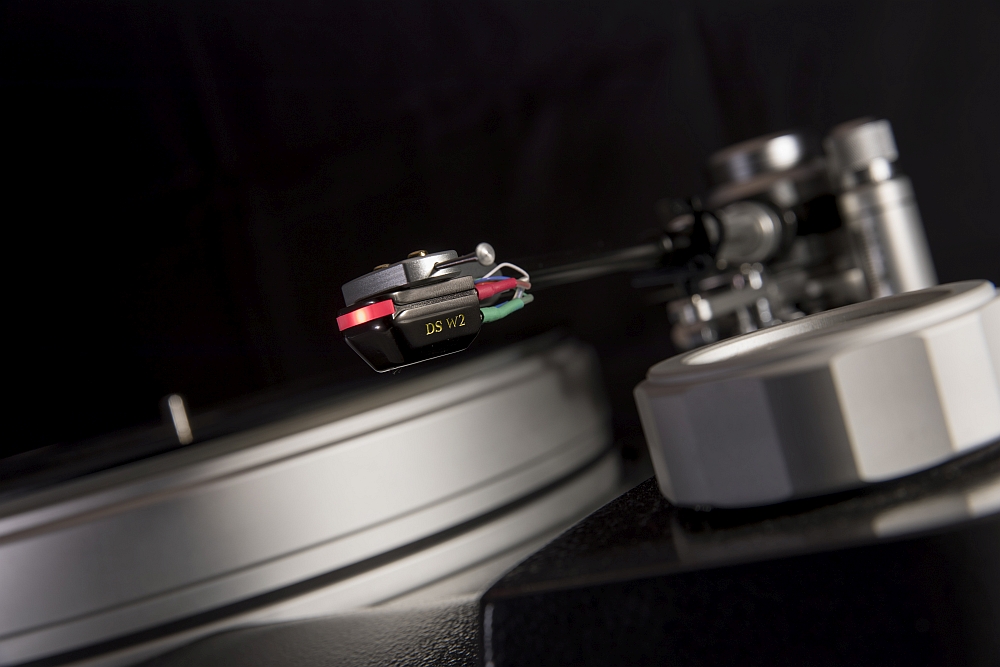
The DS Audio pairings are an acquired taste, and something that will take (or at least took me) some getting used to; but will quite possibly elevate your experience of your favourite recordings to new heights.
Sophisticated and demure in nature, the DS-W2 will simultaneously shower you in detail, transparency, soundstaging and tonal fidelity found in only the finest of playback equipment and, while I would advise caution in selecting the DS Audio offerings based on the particular setup singularities that I’ve described, I would wholeheartedly recommend a serious audition of their gear before rushing into anything else.
When compared to the price of cartridge and phono stage separates in the current market, the DS Audio DS-W2 cartridge and equaliser present themselves as both novel and highly cost-effective solutions to vinyl playback at a very high level indeed.
… Josh Givorshner
www.soundstageaustralia.com
Associated Equipment
- Digital – Ypsilon CDT-100
- Analogue – TechDAS Air Force One on Meiritz-Seiki ME40-D active workstation table, TW Acustic Raven AC with Black Night motor / controller, Kuzma Airline tonearm, MySonic Labs Signature Gold MC cartridge, Ypsilon MC 10-L step-up transformer
- Preamplifier – Halcro dm10, Kondo Audio Note M7, Aesthetix IO Eclipse (dual PSU)
- Amplifier – Ypsilon SET-100 Ultimate Mk. II
- Speakers – Evolution Acoustics MMMiniTwo
- Power – Shunyata Hydra Triton, DBA LB-1500 line balancer (x2), PS Audio P-500
- Cables – PSC Monolith, Tara Labs Zero Edge, ZenSati #2, Shunyata ZiTron Alpha HC, Anaconda Vx, Python Alpha, Taipan Alpha, Vitus Andromeda
- Equipment Rack – Taoc ASR-II
- Accessories – Acoustic Revive RR-888, Multiple Telos Audio components (QMT, QNR, GNR), Symposium Ultra Platforms, Symposium Rollerblock and Rollerblock Jr, Stillpoints Ultra SS, Herbie’s Audio Lab Gabon ebony domes
DS Audio DS-W2 Phono Cartridge & Equaliser
Price: AU$17,900
Warranty: Twelve Months
Australian Distributor: Absolute Hi End
+61 488 777 999
www.absolutehiend.com
DS Audio
+81-42-747-0900
4 Chome-50-40 Kamitsurumahonchō
Minami-ku, Sagamihara-shi, Kanagawa-ken 252-0318
www.ds-audio-w.biz
